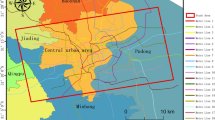Abstract
This paper introduced an advanced SBAS algorithm to investigate the subsidence time-series of reclaimed lands. A new method for fusing persistent and distributed scatterers in time-series images was presented in this algorithm. Moreover, nonlocal filter based on DS was employed for the interferometric phase which improved results quality with high spatial resolution. The reclaimed lands near Hong Kong Science Park and Hong Kong Disneyland (HKD) were selected for the investigation by high-resolution TerraSAR-X images. The reclaimed lands area was classified into three types labeled as undeveloped area, developing area and developed area. The results showed that: Undeveloped area had significant subsidence due to soft soil consolidation, especially in HKD’s reclaimed lands with deformation rate up to −459 mm/year; developing and developed area also had subsidence phenomenon due to building pressure caused by mass constructions of infrastructure. In particular, in the preliminary stage after construction, there was a dramatic subsidence trend, which easily threatened the security and stability of infrastructure facilities such as underground pipes and drainage system.












Similar content being viewed by others
References
Ao M, Wang C, Xie R et al (2015) Monitoring the land subsidence with persistent scatterer interferometry in Nansha District, Guangdong, China. Nat Hazards 75(3):2947–2964
Berardino P, Fornaro G, Lanari R et al (2002) A new algorithm for surface deformation monitoring based on small baseline differential SAR interferograms. IEEE Trans Geosci Remote Sens 40(11):2375–2383
Berti M, Corsini A, Franceschini S et al (2013) Automated classification of persistent scatterers interferometry time series. Nat Hazards Earth Syst Sci 13(8):1945–1958
Buades A, Coll B, Morel JM (2005) A non-local algorithm for image denoising. Computer vision and pattern recognition, CVPR 2005. IEEE Comput Soc Conf IEEE 2:60–65
Casu F, Manzo M, Lanari R (2006) A quantitative assessment of the SBAS algorithm performance for surface deformation retrieval from DInSAR data. Remote Sens Environ 102(3):195–210
Cavalié O, Doin MP, Lasserre C et al (2007) Ground motion measurement in the Lake Mead area, Nevada, by differential synthetic aperture radar interferometry time series analysis: probing the lithosphere rheological structure. J Geophys Res 112. doi:10.1029/2006JB004344
Chen F, Lin H, Hu X (2014) Slope superficial displacement monitoring by small baseline SAR interferometry using data from L-band ALOS PALSAR and X-band TerraSAR: a case study of Hong Kong, China. Remote Sens 6(2):1564–1586
Costantini M, Rosen P (1999) A generalized phase unwrapping approach for sparse data. Geoscience and remote sensing symposium, 1999, IGARSS’99 proceedings, IEEE 1999 international, IEEE, 1:267–269
De Zan F, Rocca F (2005) Coherent processing of long series of SAR images. Int Geosci Remote Sens Symp 3:1987
Deledalle CA, Denis L, Tupin F (2009) Iterative weighted maximum likelihood denoising with probabilistic patch-based weights. Image Process IEEE Trans 18(12):2661–2672
Deledalle CA, Denis L, Tupin F (2011) NL-InSAR: nonlocal interferogram estimation. IEEE Trans Geosci Remote Sens 49(4):1441–1452
Doin MP, Lasserre C, Peltzer G et al (2009) Corrections of stratified tropospheric delays in SAR interferometry: validation with global atmospheric models. J Appl Geophys 69(1):35–50
Ferretti A, Prati C, Rocca F (2000) Nonlinear subsidence rate estimation using permanent scatters in differential SAR interferometry. IEEE Trans Geosci Remote Sens 28(5):2202–2212
Ferretti A, Prati C, Rocca F (2001) Permanent scatters in SAR interferometry. IEEE Trans Geosci Remote Sens 39(1):8–20
Ferretti A, Fumagalli A, Novali F et al (2011) A new algorithm for processing interferometric data-stacks: SqueeSAR. Geosci Remote Sens IEEE Trans 49(9):3460–3470
Goel K, Adam N (2012) An advanced algorithm for deformation estimation in non-urban areas. ISPRS J Photogramm Remote Sens 73:100–110
Graham J, Yin JH (2001) On the time-dependent stress–strain behaviour of soft soils. In: Lee CF, Lau CK, Ng CWW, Kwong AKL, Pang PLR, Yin J-H, Yue ZQ (eds) Soft Soil Engineering. A.A. Balkema Publishers, Lisse, pp 13–23
Guarnieri AM, Tebaldini S (2008) On the exploitation of target statistics for SAR interferometry applications. Geosci Remote Sens IEEE Trans 46(11):3436–3443
Hooper A, Zebker H, Segall P, Kampes B (2004) A new method for measuring deformation on volcanoes and other natural terrains using InSAR persistent scatterers. Geophysical research letters 31. doi:10.1029/2004GL021737
Jiang L, Lin H (2010) Integrated analysis of SAR interferometric and geological data for investigating long-term reclamation settlement of Chek Lap Kok Airport, Hong Kong. Eng Geol 110(3):77–92
Jiang L, Lin H, Cheng S (2011) Monitoring and assessing reclamation settlement in coastal areas with advanced InSAR techniques: Macao city (China) case study. Int J Remote Sens 32(13):3565–3588
Kvam PH, Vidakovic B (2007) Nonparametric statistics with applications to science and engineering. Wiley, NewYork, p 653
Lin YN, Simons M, Hetland EA et al (2010) A multiscale approach to estimating topographically correlated propagation delays in radar interferograms. Geochem Geophys Geosyst 11(9). doi:10.1029/2010GC003228
Main IG, Leonard T, Papasouliotis O et al (1999) One slope or two? Detecting statistically significant breaks of slope in geophysical data, with application to fracture scaling relationships. Geophys Res Lett 26(18):2801–2804
Mora O, Mallorqui JJ, Broquetas A (2003) Linear and nonlinear terrain deformation maps from a reduced set of interferometric SAR images. IEEE Trans Geosci Remote Sens 41(10):2243–2252
Schmidt DA, Bürgmann R (2003) Time-dependent land uplift and subsidence in the Santa Clara valley, California, from a large interferometric synthetic aperture radar data set. J Geophys Res 108:2416–2428
Stephens MA (1970) Use of the Kolmogorov–Smirnov, Cramér-Von Mises and related statistics without extensive tables. J R Stat Soc Ser B (Methodological) 1970:115–122
Wang H, Wright TJ, Yu Y et al (2012a) InSAR reveals coastal subsidence in the Pearl River Delta, China. Geophys J Int 191(3):1119–1128
Wang Y, Zhu XX, Bamler R (2012b) Retrieval of phase history parameters from distributed scatterers in urban areas using very high resolution SAR data. ISPRS J Photogramm Remote Sens 73:89–99
Zhao Q, Lin H, Gao W et al (2011) InSAR detection of residual settlement of an ocean reclamation engineering project: a case study of Hong Kong International Airport. J Oceanogr 67(4):415–426
Zebker HA, Chen K (2005) Accurate estimation of correlation in InSAR observations. Geosci Remote Sens Lett IEEE 2(2):124–127
Acknowledgments
The TerraSAR-X data used in this study were provided by Infoterra, Germany. This research was supported by the National Natural Science Foundation of China (No. 41274048).
Author information
Authors and Affiliations
Corresponding author
Rights and permissions
About this article
Cite this article
Wang, M., Li, T. & Jiang, L. Monitoring reclaimed lands subsidence in Hong Kong with InSAR technique by persistent and distributed scatterers. Nat Hazards 82, 531–543 (2016). https://doi.org/10.1007/s11069-016-2196-1
Received:
Accepted:
Published:
Issue Date:
DOI: https://doi.org/10.1007/s11069-016-2196-1




